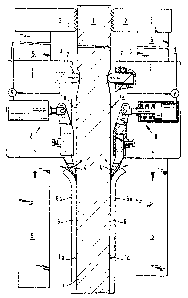Une partie des informations de ce site Web a été fournie par des sources externes. Le gouvernement du Canada n'assume aucune responsabilité concernant la précision, l'actualité ou la fiabilité des informations fournies par les sources externes. Les utilisateurs qui désirent employer cette information devraient consulter directement la source des informations. Le contenu fourni par les sources externes n'est pas assujetti aux exigences sur les langues officielles, la protection des renseignements personnels et l'accessibilité.
L'apparition de différences dans le texte et l'image des Revendications et de l'Abrégé dépend du moment auquel le document est publié. Les textes des Revendications et de l'Abrégé sont affichés :
| (12) Brevet: | (11) CA 1317562 |
|---|---|
| (21) Numéro de la demande: | 1317562 |
| (54) Titre français: | METHODE ET APPAREIL SERVANT A RETIRER DES PRECIPITES ELECTROLIQUES DE LEUR SUPPORT |
| (54) Titre anglais: | METHOD AND APPARATUS FOR STRIPPING ELECTROLYTIC PRECIPITATE FROM SUPPORTING STRUCTURES |
| Statut: | Durée expirée - après l'octroi |
| (51) Classification internationale des brevets (CIB): |
|
|---|---|
| (72) Inventeurs : |
|
| (73) Titulaires : |
|
| (71) Demandeurs : |
|
| (74) Agent: | NORTON ROSE FULBRIGHT CANADA LLP/S.E.N.C.R.L., S.R.L. |
| (74) Co-agent: | |
| (45) Délivré: | 1993-05-11 |
| (22) Date de dépôt: | 1987-10-01 |
| Licence disponible: | S.O. |
| Cédé au domaine public: | S.O. |
| (25) Langue des documents déposés: | Anglais |
| Traité de coopération en matière de brevets (PCT): | Non |
|---|
| (30) Données de priorité de la demande: | ||||||
|---|---|---|---|---|---|---|
|
(57) ABSTRACT
The invention relates to a method and apparatus for stripping
a thin, sheet-like layer of electrolytically accumulated
metal precipitate (6) from its supporting structures (1) by
means of a peeling blade (4) driven towards the upper edge of
the precipitate layer (6). For the stripping operation, the
supporting structure (1) is first attached to the stripping
station by aid of gripping members (2, 3), the frame whereof
advantageously provides a housing in common with the peeling
blades (4). Moreover, the measuring and control members (7,
8) which are advantageously located in the common housing, are
used in determining the surface profile of the supporting
structure (1), and the obtained profile is made use of while
choosing the orientation of the peeling blade (4).
Note : Les revendications sont présentées dans la langue officielle dans laquelle elles ont été soumises.
Note : Les descriptions sont présentées dans la langue officielle dans laquelle elles ont été soumises.

2024-08-01 : Dans le cadre de la transition vers les Brevets de nouvelle génération (BNG), la base de données sur les brevets canadiens (BDBC) contient désormais un Historique d'événement plus détaillé, qui reproduit le Journal des événements de notre nouvelle solution interne.
Veuillez noter que les événements débutant par « Inactive : » se réfèrent à des événements qui ne sont plus utilisés dans notre nouvelle solution interne.
Pour une meilleure compréhension de l'état de la demande ou brevet qui figure sur cette page, la rubrique Mise en garde , et les descriptions de Brevet , Historique d'événement , Taxes périodiques et Historique des paiements devraient être consultées.
| Description | Date |
|---|---|
| Inactive : Périmé (brevet sous l'ancienne loi) date de péremption possible la plus tardive | 2010-05-11 |
| Accordé par délivrance | 1993-05-11 |
Il n'y a pas d'historique d'abandonnement
| Type de taxes | Anniversaire | Échéance | Date payée |
|---|---|---|---|
| TM (catégorie 1, 5e anniv.) - générale | 1998-05-11 | 1998-04-14 | |
| TM (catégorie 1, 6e anniv.) - générale | 1999-05-11 | 1999-04-14 | |
| TM (catégorie 1, 7e anniv.) - générale | 2000-05-11 | 2000-04-13 | |
| TM (catégorie 1, 8e anniv.) - générale | 2001-05-11 | 2001-04-17 | |
| TM (catégorie 1, 9e anniv.) - générale | 2002-05-13 | 2002-04-16 | |
| TM (catégorie 1, 10e anniv.) - générale | 2003-05-12 | 2003-04-16 | |
| TM (catégorie 1, 11e anniv.) - générale | 2004-05-11 | 2004-04-13 | |
| TM (catégorie 1, 12e anniv.) - générale | 2005-05-11 | 2005-04-13 | |
| TM (catégorie 1, 13e anniv.) - générale | 2006-05-11 | 2006-04-13 | |
| TM (catégorie 1, 14e anniv.) - générale | 2007-05-11 | 2007-04-13 | |
| TM (catégorie 1, 15e anniv.) - générale | 2008-05-12 | 2008-04-16 | |
| TM (catégorie 1, 16e anniv.) - générale | 2009-05-11 | 2009-04-30 |
Les titulaires actuels et antérieures au dossier sont affichés en ordre alphabétique.
| Titulaires actuels au dossier |
|---|
| OUTOKUMPU OY |
| Titulaires antérieures au dossier |
|---|
| MATTI OLAVI LEIPONEN |
| OLLI ERKKI YLIMAKI |
| PENTTI KAARLO KUJANPAA |
| SEPPO JUHANI ERLAMO |